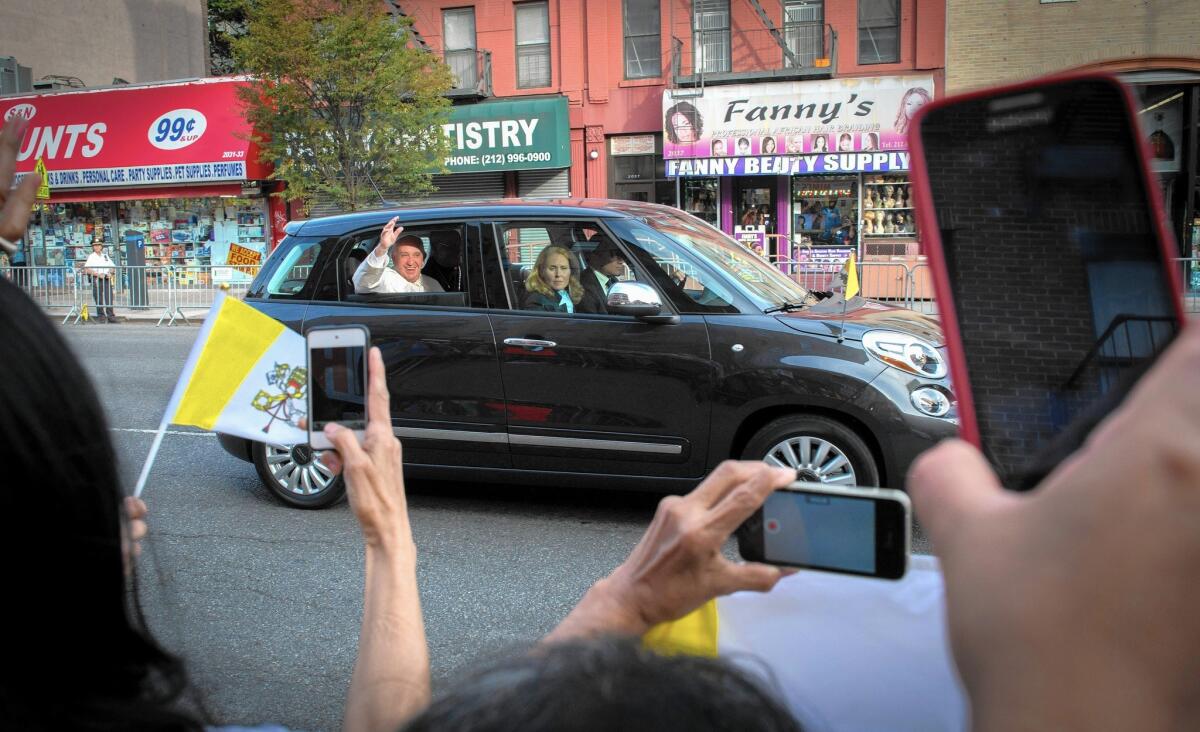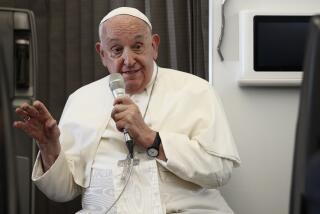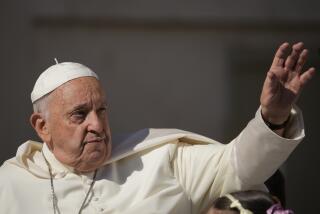Analysis: With Pope Francis, Catholicism has a new brand -- an everyman’s pope

Pope Francis waves from the back seat of a Fiat during his visit to New York. The symbolism of the simple car resonated as powerfully as any of his speeches.
- Share via
Among the memorable images from Pope Francis’ visit to the United States are the pontiff addressing Congress, celebrating Mass at Madison Square Garden and standing before Independence Hall.
Then there’s the black Fiat hatchback.
The 1.4-liter model 500L starts at $19,345 and gets 33 miles per gallon on the highway.
An everyman’s car.
As Francis scooted around Washington and Philadelphia in the back seat, eschewing the gas-guzzling Mercedes SUV of his predecessor, the symbolism resonated as powerfully as any of his speeches:
An everyman’s pope.
Returning the Roman Catholic Church to the people is his mission. Just maybe, church watchers and members say, the legacy of his first trip to the United States will be to fill the pews a little deeper.
He heads an embattled church that is losing membership to evangelical denominations and ailing from the clergy sex abuse scandal that produced multimillion-dollar settlements that forced financially strapped dioceses to close schools and parishes.
Francis’ approach marks a sharp departure from that of the last two popes, who saw the church as a bulwark against secular culture and cast themselves as God’s messengers of moral code.
His cerebral predecessor, Benedict XVI, came across as cold and distant and did little to soften attitudes toward the faith followed by 1.2 billion people worldwide. Benedict frequently decried moral relativism and Europe’s loss of its Christian roots.
Pope John Paul II famously condemned abortion, the death penalty and euthanasia as the “culture of death” and the single alternative to the “culture of life.”
Francis has not tried to change church doctrine. But he is recasting the church’s role in a rapidly changing society.
“Francis is not a scolder,” said Father James Bretzke, a professor of moral theology at Boston College. “His mantra is dialogue, reconciliation, mercy and forgiveness.”
“He is inviting the world — both the great and powerful as well as the weak and marginalized — to see themselves as deeply loved by God and to join together working for what Catholic social teaching calls the ‘common good.’”
In six days on American soil, as the pope urged gentler immigration policies, swift action on global warming and more equitable distribution of wealth, he took every opportunity to show that at the core he too is just a man.
He led by Fiat, not fiat.
He set the tone with the second sentence of his speech at the White House welcoming ceremony Wednesday: “As the son of an immigrant family, I am happy to be a guest in this country, which was largely built by such families.”
He waded into roaring crowds to pose with his fans for selfies and more than once ordered his anxious security detail to stand down.
He wore frayed cassocks and asked people to pray for him — and for nonbelievers to at least think good thoughts. He ministered to prisoners and turned down lunch with Washington dignitaries Thursday to dine with the homeless.
He even had the right soundtrack. At Philadelphia’s Independence Hall on Saturday, he entered to Aaron Copland’s “Fanfare for the Common Man.”
NEWSLETTER: Get the day’s top headlines from Times Editor Davan Maharaj >>
The deliberations of the College of Cardinals are secret, so no one knows what led to Francis’ election — though, theologically speaking, cardinals have long said they are guided by the Holy Spirit in choosing a new pope. But Francis’ introduction to the world as the 266th pontiff on March 13, 2013, came at a crucial time.
Given all of its modern problems, the ancient church needed a rebranding.
Close observers say that 78-year-old Francis is simply being himself, with values forged in a Jesuit tradition that emphasizes humility and service to the downtrodden. He doesn’t pretend to have all the answers. Unlike his predecessors, he never served in the Vatican administration before becoming pope. In his native Argentina, where he spent most of his career, he often rode the public bus.
“I think he really does experience the tension between the Gospel and the gilded elements of his office that have developed over the centuries,” said Richard Miller, a professor of theology at Creighton University in Nebraska.
The Fiat, he said, is “an attempt to live more simply and authentically despite his position.”
The message, from the church, is that its appeal is simple and authentic. Francis, in essence, is a rebranding of Catholicism.
“He talks not like a pope, but like someone from my town, like a normal person,” 51-year-old Gerardo Flores, a Mexican immigrant, said at a massive gathering for the pope in Philadelphia.
“His words are going to change the ideas of the politicians,” he said.
Even many non-Catholics have been drawn to the church’s effort to project a new face to the world.
Whether Francis’ popularity can translate to political change is unclear. Nor is he without detractors. Conservatives complain that he doesn’t advocate enough for doctrine, especially opposition to abortion. Others say his warm exterior masks policies that disregard or denigrate women.
Still, while he may not change attitudes toward global warming or immigration policy, Francis is likely to have greater success in reviving interest in the church.
There were already signs before his visit that the so-called Francis effect is real. In a recent U.S. poll by the Public Religion Research Institute, 61% of Catholics said they thought he would attract more people back to the church, and 29% of “former Catholics” said the same thing.
“I have a lot of friends at work who are lapsed Catholics who have said they are thinking about coming back to the church,” said Greg Sekela, 55, one of the throngs attending the pope’s Mass in Philadelphia on Sunday. “He’s been a breath of fresh air.”
Michael Peppard, a professor of theology at Fordham University in New York, said authenticity is key for the church to attract a new generation of believers.
“Young people especially have a sensitive nose for hypocrisy, a fault which plagues most human institutions,” Peppard said. “But in Francis they see a leader who walks the walk first, and only then follows it up with words.
“Through his actions of mercy, listening in dialogue, and disavowing worldly comforts typically lavished on world leaders, this pope has opened up opportunities for people to hear the message of Jesus anew.”
Or as Father James Heft, a professor of religion at USC and president of the Institute for Advanced Catholic Studies, said a colleague recently put it: Francis “hasn’t changed the words; he’s changed the music.”
“Music is powerful,” Heft said.
Careful observers noticed the license plate on the Fiat: SCV 1. In Italian, it stands for the Vatican City State.
Italians used to see the plate on much more luxurious vehicles, and mocked it as a sign of a church out of touch with ordinary people.
“Se Cristo vedesse,” they used to say with irony.
Now, they say it with a chuckle: “If Christ could only see this.”
Twitter: @AlanZarembo
MORE ON THE POPE’S HISTORIC VISIT
‘God bless America,’ Pope Francis says as his U.S. visit comes to an end
Crowd protests tent blocking view at pope’s Mass -- look what happened
Pope to prisoners: ‘I am here as a pastor, but above all as a brother’
More to Read
Sign up for Essential California
The most important California stories and recommendations in your inbox every morning.
You may occasionally receive promotional content from the Los Angeles Times.











